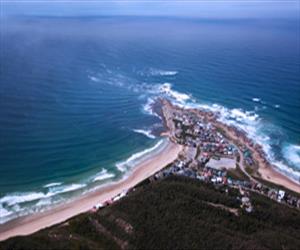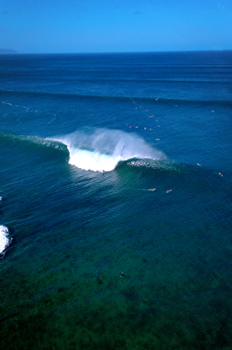Different Wave Types for Surfing
 Thank the Sun. Surfers owe the Sun a greater debt of gratitude than the rest of life on our planet. Solar energy creates the wind energy that ultimately produces wave energy — and without all of this energy you’d probably be waxing up your sandboard instead of your surfboard right about now.
Thank the Sun. Surfers owe the Sun a greater debt of gratitude than the rest of life on our planet. Solar energy creates the wind energy that ultimately produces wave energy — and without all of this energy you’d probably be waxing up your sandboard instead of your surfboard right about now.
That being said, the more you understand about how wave energy is transformed into epic surfing waves, the better you’ll be able to harness these incredibly powerful forces of nature. This guide discusses all things having to do with wave types.
Types of Swell
When the wind blows on the surface of the ocean it creates wave energy. As this energy travels through the open ocean it becomes an organized swell. There are two main types of swell. Each one will have a different affect on the waves that break at your surf spot:
- Ground: Groundswell is generated by storms and very strong winds over a long distance in the open ocean — the bigger the storm the more punch the swell will be packing. This wave energy can reach as deep as 1,000 feet and travel for thousands of miles, ultimately producing stellar surfing waves.
- Wind: This kind of swell is created by wind that is much more localized and closer to shore. As a result, this type of wave energy doesn’t run as deep and is generally not nearly as powerful as groundswell.
At times, surf spots are hit by both ground and wind swells from multiple directions simultaneously.
Refraction
When swells eventually reach shallow water they slow down and the wave energy is released in the form of breaking waves. This energy is focused toward the more shallow areas of water, since that section of the wave isn’t moving as fast as the sections traveling over deeper water. The way in which the line of swell bends horizontally as it breaks is called “refraction” — and is dependent on landscape characteristics and the depth of the sea floor. There are two types of refraction you’ll notice at surf spots:
- Concave: When a line of swell travels over a raised bottom contour that has deeper water around it, the farthest ends of the wave will bend toward the shore. From the side, the wave looks like a “bowl” with energy focused at a peak in the middle. This is known as “concave refraction” and can produce excellent surfing waves that can be ridden to the left or the right of the peak.
- Convex: When a line of swell encounters a headland, for example, with deeper water adjacent to it, the middle of the wave will bend away from the deep water and toward the shoreline. As a result, wave energy is “defocused” or spread over a wide area. This is known as “convex refraction” and can result in less powerful waves but longer rides than the concave variety.
The energy contained in ocean waves is immense. Even small surfing waves are capable of lifting thousands of tons of water — that’s like elevating thousands of small cars at the same time!
Types of Breaks
There are three types of breaks that produce waves for surfing:
- Beach: These breaks are waves that break on sandbars. Wave shape, size, and peak location at beach breaks can vary significantly from day to day as the sand shifts. The sandy bottom at these breaks makes them a safer choice for novice surfers.
- Reef: Reef breaks are waves that break on shelves of rock or coral. Unlike beach breaks, reef breaks are much more consistent in terms of wave shape and peak location. Most importantly for surfers, reefs can create phenomenal waves.
- Point: Point breaks are simply areas where waves break on a section of land that juts out from shore. When swells come from the right direction, they will wrap around these points to create epic waves. Some of the most consistent spots in the world, with the best-shaped waves and the longest rides, are point breaks.
Types of Waves
 The swell size and direction, as well as the tide, currents, and wind, heavily influence the conditions at every surf spot. Depending on the following variables, several different kinds of waves can be found at a break:
The swell size and direction, as well as the tide, currents, and wind, heavily influence the conditions at every surf spot. Depending on the following variables, several different kinds of waves can be found at a break:
- Closeouts: Waves that break all at once instead of peeling are called closeouts. They create a lot of whitewater without a clean wave face, making them not ideal for surfing.
- Crumbly: These gently breaking waves are not very steep, fast, or hollow, and are produced when the bottom contour is more gradual. Crumbly waves are also referred to as “mushy” waves, because they don’t contain a great deal of power. The forgiving nature of crumbly waves makes them perfect for beginner surfers.
- Reforms: This type of wave will sometimes break and then die down as it hits deeper water before “reforming” or breaking again — caused by varying bottom depth. Depending on the spot and the conditions, advanced surfers may kick out before the wave hits deeper water, leaving the inside reform to less experienced surfers.
- Tubing: These hollow waves and barrels (also known as “plunging” waves) are generated when a swell rolls through deep water and then hits a much more shallow area. This type of wave is highly sought after by experienced surfers. Novices should steer clear.
- Double-ups: This type of wave arrives when two waves meet and their crests and troughs align. This wave energy combines to create an extra powerful and larger wave. Double-ups can become ultra hollow and even dangerous when they break. Even surfers with very advanced skills can have a tough time taming these wild beasts.
Not in Vain
Becoming a student of your surf spot and noticing things like landscape features, bottom contours, tides, best swell size and direction will help you anticipate wave behavior. In turn, the ability to predict what waves do will lead to better surfing. After all, you owe it to the wave energy that travels to your local break to not end its journey in vain.
